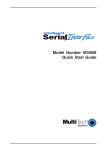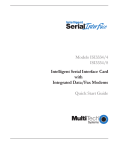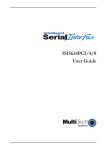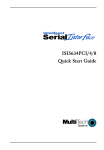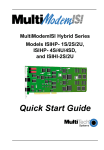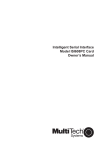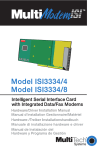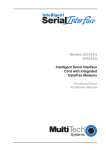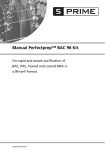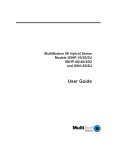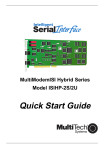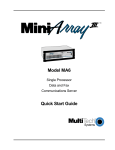Download Multitech ISI4608 User guide
Transcript
ISI4608-PCI & ISI4604-PCI
User Guide
User Guide
P/N S0000112, Revision C
Model ISI4608-PCI
This publication may not be reproduced, in whole or in part, without prior
expressed written permission from Multi-Tech Systems, Inc. All rights reserved.
Copyright © 2001 by Multi-Tech Systems, Inc.
Multi-Tech Systems, Inc. makes no representation or warranties with respect to the
contents hereof and specifically disclaims any implied warranties of merchantability
or fitness for any particular purpose. Furthermore, Multi-Tech Systems, Inc.
reserves the right to revise this publication and to make changes from time to time in
the content hereof without obligation of Multi-Tech Systems, Inc. to notify any
person or organization of such revisions or changes.
Record of Revision
Revision
Description
A
(11/11/98)
Manual released. All pages at Revision A.
B
(8/25/00)
C
(5/8/01)
Revised for ISI universal drivers and to include ISI4604-PCI.
Info added on Win 2000, MTS Patent, Win Me, Novell,
Linux, & regulatory matters.
TRADEMARKS
The Multi-Tech logo is a registered trademark of Multi-Tech Systems, Inc.
Windows 2000, Windows NT, Windows 95, Windows 98, and Windows Me are
registered trademarks of Microsoft.
Pentium is a registered trademark of Intel Corporation.
Contact Info
Patent Info
Multi- Tech Systems, Inc.
2205 Woodale Dr.
Mounds View, Minnesota
55112, U.S.A.
(763) 785- 3500
(800) 328- 9717
U.S. Fax: (763) 785- 9874
Tech Support:
(800) 972- 2439
Internet: www.multitech.com
This device is covered by one or more of the following
patents: 6,031,867; 6,012,113; 6,009,082; 5,905,794;
5,864,560; 5,815,567; 5,815,503; 5,812,534;
5,809,068; 5,790,532; 5,764,628; 5,764,627;
5,754,589; D394,250; 5,724,356; 5,673,268;
5,673,257; 5,644,594; 5,628,030; 5,619,508;
5,617,423; 5,600,649; 5,592,586; 5,577,041;
5,574,725; D374,222; 5,559,793; 5,546,448;
5,546,395; 5,535,204; 5,500,859; 5,471,470;
5,463,616; 5,453,986; 5,452,289; 5,450,425;
D361,764; D355,658; D355,653; D353,598;
D353,144; 5,355,365; 5,309,562; 5,301,274. O ther
Patents Pending
Contents
Chapter 1Introduction and Description .............................. 5
Introduction to the IntelligentSerialInterface .......................................... 6
Product Description ................................................................................ 6
How to Use This Manual ........................................................................ 7
ISI460x-PCI Applications ........................................................................ 8
Technical Specifications ......................................................................... 8
Computer Requirements .................................................................. 8
Physical/Electrical/Environmental ................................................... 8
Chapter 2Hardware Installation ....................................... 11
Introduction .......................................................................................... 12
Safety Warnings Telecom ..................................................................... 12
Hardware Installation Procedures ......................................................... 12
Chapter 3Driver Installation ............................................. 15
Introduction .......................................................................................... 16
Installing ISI460x-PCI Software for Windows 2000 ............................... 17
ISI460x-PCI for Windows 2000: Installing ISI Management Software ... 24
Remove ISI460x-PCI Driver (Windows 2000) ........................................ 26
ISI460x-PCI Software Install for Windows NT 3.51/4.0 ........................ 26
Removing ISI4608x-PCI Card and Driver in Windows NT 3.51/4.0 ........ 29
I/O Addresses and IRQ Codes .............................................................. 30
ISI460x-PCI Software Install for Windows 95/98/Me ........................... 31
Removing the ISI460x-PCI Driver (Windows 95/98/Me) ....................... 35
NetWare Driver Installation .................................................................. 35
Configuring Ports for NetWare Connect ....................................... 37
Removing the Driver (Novell) ........................................................ 37
SCO Open Server 5 Driver Installation .................................................. 37
To install from CD-ROM: ............................................................... 37
To format a floppy disk for SCO5: .................................................. 38
To untar the driver file and copy files onto floppy disk: ................ 38
To install driver from floppy disk ................................................... 39
MultiTech Installation Script ......................................................... 40
Activating Ports in SCO Open Server 5 ................................................ 43
Removing the Driver (SCO Open Server 5) .................................... 45
Chapter 3: Driver Installation (continued)
Linux Driver for Multi-Tech ISI460x-PCI Server Cards .......................... 45
LINUX: Pre-Installation Issues ...................................................... 45
LINUX: Copying the driver from the media ................................... 45
LINUX: Copying and untarring the driver from CD-ROM ............. 45
LINUX: Copying and untarring the driver from a floppy ............... 46
LINUX: Driver installation and loading ......................................... 47
LINUX: Setting the baud rate ........................................................ 48
LINUX: Verifying the ports ............................................................ 48
LINUX: TTY Devices Created by the Drivers: ............................... 48
LINUX -- Dial-in configuration: .................................................... 50
LINUX -- PPP setup: ...................................................................... 50
Removing the ISI Driver (Linux) ........................................................... 51
Chap 4: Warranty, Service, & Tech Support ........................ 53
Warranty, Service & Tech Support ....................................... 54
Limited Warranty .................................................................................. 54
Addendum for North American Products ............................................. 54
Addendum for International Products .................................................. 55
Out of Warranty Repair Cost Charts ..................................................... 56
Upgrades and Product Support via Internet ......................................... 56
Technical Support ................................................................................. 56
Recording ISI460x-PCI Information ....................................................... 57
Software User License Agreement ........................................................ 57
On-Line Warranty Registration ............................................................. 59
About the Internet ................................................................................... 59
Appendix ACrossover Cable Wiring Diagrams ............... 62
Appendix BRegulatory Information ................................. 64
Index ....................................................................................... 67
Chapter 1—Introduction and Description
ISI4608-PCI User Guide
Introduction to the IntelligentSerialInterface
The Intelligent Serial Interface cards, model ISI4608-PCI and ISI4604PCI, are hardware solutions for adding fast serial ports to
communication servers and async hosts that have 32-bit PCI bus
architecture.
Serial ports are essential to
Communication servers that pool modems and other
communication devices for users on a LAN and to
Asynchronous hosts that provide user access through serial
ports.
Each ISI4604-PCI card adds four serial ports to the computer; each
ISI4608-PCI card adds eight serial ports to the computer. (From now on
in this manual we will use ISI460x-PCI when referring to both
models.) The ISI460x-PCI ships with drivers for the following multiuser
operating systems: Windows® 2000 Server and Advanced Server,
Windows NT, versions 3.51 and 4.0; Windows 95, Windows 98, and
Windows Me.
The IntelligentSerialInterface card can be combined to support
asynchronous serial devices (local or dial-up). The ports can be used
to connect basic terminals with or without multiple pages of memory to
multiplexer channels and asynchronous modems. Each ISI460x-PCI port
can support as many screens as there are physical pages of memory on
the terminal. In Windows NT, a built-in autodetect utility enables
detection of Multi-Tech modems and sets the proper initialization
strings.
This manual contains product specifications, installation instructions,
and technical support information to assist you in the installation
process. It is assumed you have basic PC skills. Therefore, we have not
included step-by-step instructions for basic operations such as
logging in and file editing, etc.
Product Description
The ISI460x-PCI is a multiport serial port expansion card that adds data
buffering on each port for enhanced serial port performance. The
ISI460x-PCI features an on-board microprocessor to coordinate the
6
Chapter 1—Introduction and Description
communications activity of your local and remote terminals. Using the
ISI460x-PCI to provide additional serial connections enables your
systems processor to perform more efficiently since the ISI460x-PCI
handles all byte-by-byte interrupts generated by asynchronous
terminals and stores the data in buffers.
The processor, along with 256K bytes of RAM, work to allocate
resources dynamically to the most active port. The ISI then generates
one interrupt for an entire block of information and transfers the block
to the systems microprocessor.
The ISI4608-PCI has one 78-pin (DB78S) connector that interfaces with
an eight-port fan-out, or octopus, cable (supplied with the card), that
provides eight additional serial ports. The ISI4604-PCI has a four-port
fan-out cable (supplied with the card), that provides four additional
ports. Both are 3/4 size add-on cards that support a high-speed
interface up to 460 Kbps.
MultiTechs ISI Management Software is shipped with the ISI460x-PCI
server card. It is designed to monitor data traffic and control the
modems attached to the ISI460x-PCI card in a computer using
Windows 2000 Server or Windows 2000 Advanced Server as its
operating system.
How to Use This Manual
This manual presents installation procedures for the ISI460x-PCI card
and for its software drivers. It contains information about technical
support and warranty coverage, as well as appendices for wiring and
regulatory matters. Hardware configuration and installation
procedures are described in Chapter 2. Installing the ISI460x-PCI card
also involves linking a driver to the operating system. This information
is presented in Chapter 3.
Most of the steps listed in the driver installation section instruct you
to press ENTER. This is a reference to the key commonly known as the
Enter, carriage-return, or Return key. Also, please note the difference
between the letter O and the number 0. Both the letter and the number
may be used in this manual.
7
ISI4608-PCI User Guide
ISI460x-PCI Applications
The ISI460x-PCI is an ideal solution for adding ports when a powerful
microcomputer used as a server or host lacks enough connectivity to
accommodate the desired number of users. The ISI4608-PCI provides
eight additional serial ports with every card installed, with a potential
of four additional cards installed per systemfor a total of thirty-two
serial ports per system. The ISI4604-PCI provides four additional serial
ports with every card installed, with a potential of four additional cards
installed per systemfor a total of sixteen serial ports per system.
Technical Specifications
Computer Requirements
386, 486, or Pentium®- based PC or compatible with PCI bus
architecture
Microsoft Windows 2000 Server and Advanced Server; Windows
NT v. 3.51 and v. 4.0; Windows 95, Windows 98, and Windows
Me; Linux (kernels 2.0, 2.2, and 2.4); SCO Open Server 5; Novell
Netware.
a CD-ROM drive (or, if software/drivers have been downloaded, a
floppy drive)
100K bytes of hard disk space
Physical/Electrical/Environmental
Dimensions: 6.875" x 4.2"
17.46 cm x 10.67 cm
Baud Rates: 300 bps to 460 Kbps per port
Bus Type: PCI
Connectors: DB78S
Cables: The ISI4608-PCI has an eight-port fan-out cable. DB78M
(male) interface goes to card; eight DB25 (male) connectors are
available for serial devices. The ISI4604-PCI has an four-port fanout cable. DB78M (male) interface goes to card; four DB25 (male)
connectors are available for serial devices.
Serial Interface: For ISI4608-PCI, eight RS232C or RS232D ports
for ISI4604-PCI, four RS232C or RS232D ports.
8
Chapter 1—Introduction and Description
Temperature: 32° to 120°F (0° to 50°C)
Power: 0.1 amp @ +12v DC
0.1 amp @ -12v DC
1 amp @ +5v DC
Base I/O Address: One 16-byte address space per card
Interrupt Request (IRQ): One IRQ per card (can be shared)
Warranty: Two years
Manufactured in Mounds View, MN, U.S.A.
9
ISI4608-PCI User Guide
10
Chapter 2—Hardware Installation
ISI4608-PCI User Guide
Introduction
This chapter describes installation of the Multi-Tech ISI4608-PCI as an
expansion card in your PCI bus computer.
Safety Warnings Telecom
1. Never install telephone wiring during a lightning storm.
2. Never install telephone jacks in wet locations unless the jack is
specifically designed for wet locations.
3. This product is to be used with UL and CUL listed computers.
4. Never touch uninsulated telephone wires or terminals unless the
telephone line has been disconnected at the network interface.
5. Use caution when installing or modifying telephone lines.
6. Avoid using a telephone (other than a cordless type) during an
electrical storm. There may be a remote risk of electrical shock from
lightning.
7. Do not use the telephone to report a gas leak in the vicinity of that
leak.
8. To reduce the risk of fire, use only No 26 AWG or larger
Telecommunication line Cord.
Hardware Installation Procedures
To install the ISI4608-PCI card into your PC-PCI bus computer:
1. Before handling the ISI4608-PCI, discharge any static in your body
by touching a piece of grounded metal such as the computer
chassis.
2. Carefully remove the ISI4608-PCI from its antistatic bag, handling it
only by the mounting bracket and edges. Do not touch the goldplated connectors along the bottom edge. (You may want to save
packaging for possible future use.)
3. Visually inspect the ISI4608-PCI. If you have any concerns about
its condition, call Technical Support at (800) 972-2439.
12
Chapter 2—Hardware Installation
4. To avoid damaging the ISI4608-PCI card and your PC, make sure
your computer and any peripheral equipment connected to it are
turned off. The ISI4608-PCI can be installed in a PC-AT, 386, 486,
or Pentium equivalent PCI bus computer.
5. Remove the cover of your computer as instructed in your
computers documentation.
6. Locate the unused PCI slot you will be using for your ISI4608-PCI
card and remove the slot cover according to instructions in your
computers documentation.
7. Install the ISI4608-PCI card into the selected expansion slot in the
same manner as any other add-on card, as instructed in your
computers documentation.
8. Fasten the retaining bracket to computer chassis and replace
cover.
9. Attach the octopus cable to the DB78S female connector on the
ISI4608-PCI card at the back of your computer. The RS232 ports on
the octopus cable are for connecting to modems, multiplexers or
other devices. If the other device is a local terminal port, a
crossover cable (not included) is required between the octopus
cable and the terminal port. See Appendix A for schematic of a
crossover cable.
Note: Any cables connected to the computer must be shielded to
reduce interference.
13
ISI4608-PCI User Guide
14
Chapter 3—Driver Installation
ISI4608-PCI User Guide
Figure 2-2. Octopus Cable
10. Turn on the power to the computer. You now are ready to install
the software/drivers.
Introduction
The ISI460x-PCI ships with drivers for each of the following operating
systems: Windows® 2000 Server and Advanced Server, Windows NT,
Windows 95, Windows 98, Windows Me, Novell Netware, SCO Open
Server, and Linux. This chapter describes the installation of these
drivers. We also describe installation of MultiTechs Management
Software for use with ISI cards under Windows 2000.
Installing a device driver modifies your system. For this reason, only
the super user (system administrator) is allowed to perform the
installation. If you cannot login as administrator, find the person in
your organization with this authorization (i.e., password). To begin
driver installation, login as administrator. Then proceed with the
appropriate installation section in this chapter.
16
Chapter 3—Software/Driver Installation
Installing ISI460x-PCI Software for Windows 2000
NOTE: A series of installation wizard screens will appear repeatedly
during this procedure (step 12). This is not an error. Do not discontinue
the procedure when the installation wizard screens repeatedly appear.
1. Shut down Windows 2000 and turn off the PC.
2. Install the ISI460x-PCI card in an available PCI expansion slot in
the computer. Follow the computer manufacturer's instructions
concerning installation of expansion cards. Observe standard
precautions regarding electro-static discharge (ESD) when
handling the ISI460x-PCI board (the board should be kept in its
shipping bag until used). During installation, handle the ISI460xPCI circuit card by its edges and keep one hand in contact with the
PC chassis.
3. Turn on the PC and start Windows 2000.
4. Insert the ISI driver CD-ROM into the CD-ROM drive (if drivers
have been downloaded from the MultiTech web site, they will
typically be on diskette; in that case, insert diskette into floppy
drive).
17
ISI4608-PCI User Guide
5. Windows 2000 will detect the ISI460x-PCI card. The Found New
Hardware Wizard- Welcome screen will appear.
Click Next.
6. The Install Hardware Device Drivers screen appears. Select
"Search for a suitable driver ..." and click Next.
18
Chapter 3—Software/Driver Installation
7. The Locate Driver Files screen appears (Windows 2000 is seeking
the driver for the ISI460x-PCI card). Select CD-ROM drives and
click Next.
8. The Driver File Search Results screen appears.
Click Next.
19
ISI4608-PCI User Guide
9. A progress screen will appear briefly while files are being copied.
10. A completion screen will appear.
Click Finish.
20
Chapter 3—Software/Driver Installation
11. Immediately after the ISI driver installation has been completed,
another Found New Hardware screen will appear briefly indicating
that the MultiTech ISI Port has been detected.
A second sequence of installation wizard screens appears. This
sequence of screens deals with the setting up of ISI ports. The
first screen in this sequence is the Found New Hardware Wizard -Welcome screen.
The Found New Hardware -- MultiTech ISI Port screen will appear
four times for the ISI4604-PCI and eight times for the ISI4608-PCI.
21
ISI4608-PCI User Guide
12. The Install Hardware Device Drivers screen appears.
Select Search for a suitable driver ... and click Next.
13. The Locate Driver Files screen appears (Windows 2000 is
seeking the ISI Port device driver). Select CD-ROM drives and
click Next.
14. The Driver Files Search Results screen will indicate that the
22
Chapter 3—Software/Driver Installation
isiport.inf file has been found on the CD-ROM.
Click Next.
15. A completion screen will appear. It will indicate that the first
MultiTech ISI Port has been set up successfully.
Click Finish.
23
ISI4608-PCI User Guide
Notice that the auto-detection facility of Windows 2000 will repeat
the ISI Port installation sequence 7 more times for the ISI4608PCI, or 3 more times for the ISI4604-PCI. That is, the Found New
Hardware -- MultiTech ISI Port screen will appear many times
after the ISI driver has been located. On this screen, the messages
Found New Hardware and Installing ... will appear alternately.
Please understand that the repetition of these screen sequences is
normal and is not an error. It does not indicate any problem with
your PC, or with the MultiTech ISI card, or its driver software.
16. Driver installation for the ISI460x-PCI card is complete.
ISI460x-PCI for Windows 2000: Installing ISI Management Software (server OSs only)
If you are using a Windows 2000 Server operating system ("Server" or
"Advanced Server"), you must decide whether you want to use the
MultiTech ISI Management Software in conjunction with your ISI460xPCI card. The ISI Management Software is shipped with the ISI card.
1. Turn on your computer and start Windows 2000.
2. Insert the CD-ROM containing the ISI Management Software into
your CD-ROM drive. (If ISI Management Software has been
downloaded from the MultiTech web site, it will typically be on a
diskette. In that case, insert diskette into floppy drive).
3. Go to Start | Run. In the Run window, enter the file path of the ISI
Management software. Typically, this would be
E:\SERVCARD\UTILITY\MGMT\SETUP.EXE.
Click OK.
24
Chapter 3—Software/Driver Installation
4. The ISI Management setup screen appears. At the Welcome
screen, click Next.
5. A progress screen appears while files are copied. If the Error
Creating WWW Server message appears, it may indicate that
there was an attempt to install the ISI Management Software on a
client version of Windows 2000. (The ISI Management Software
can be installed only in the Windows 2000 Server and Windows
2000 Advanced Server operating systems.)
6. A completion screen appears.
Select "Yes, I want to restart my computer now" and click Finish.
After the computer has restarted, the installation of the driver and of
the ISI Management Software will be complete.
25
ISI4608-PCI User Guide
Remove ISI460x-PCI Driver (Windows 2000)
1. Go to Start | Settings | Control Panel.
2. Click on Add/Remove Hardware. Click Next.
3. Click on Uninstall/Unplug a device and click Next.
4. In the subsequent screen, click on Uninstall a device and click
Next.
5. At the Add/Remove Hardware Wizard screen, highlight the ISI
driver file for the specific server card that you intend to remove.
Click Next.
6. When you are asked to confirm removal, click on the Yes radio
button and click Next.
7. Click Finish. You can remove the driver for only one ISI460x-PCI
card at a time.
ISI460x-PCI Software Installation Procedure
for Windows NT 3.51/4.0
1. Turn off the PC.
2. The ISI460x-PCI card must be installed in a PCI expansion slot in
the computer. If not, follow the computer manufacturer's
instructions concerning installation of expansion cards. Observe
standard precautions regarding electro-static discharge (ESD)
when handling the ISI460x-PCI board (the board should be kept in
its shipping bag until used). During installation, handle the
ISI460x-PCI circuit card by its edges and keep one hand in contact
with the computer chassis.
3. Turn on the PC and start Windows NT.
4. Insert the driver CD-ROM into the CD-ROM drive. (If drivers
were obtained from MultiTech web site and stored on diskette,
place diskette into floppy drive now.)
5. Click Start | Settings | Control Panel | Network | Adapters.
Then click Add.
26
Chapter 3—Software/Driver Installation
6. The Select Network Adapter dialog box appears. Click Have
Disk.
7. The Insert Disk dialog box appears. Type or browse for the
path (file directory location) of the Windows NT driver (for
example, E:\SERVCARD\DRIVERS\WINNT\SETUP.EXE). Click
OK.
8. The Select OEM Option dialog box appears. Click OK.
A transient dialog box will appear indicating the progress of the
setup program.
27
ISI4608-PCI User Guide
9. The ISI Cards dialog box appears. Click Add.
10. Then the ISI Card Settings dialog box appears. Enter the
correct port count:
allocate 4 ports for ISI4604-PCI cards;
allocate 8 ports for the ISI4608-PCI cards.
Select the first port number for modems, which is usually COM3.
Click "PCI" in the Bus Type field.
11. The ISI Cards dialog box appears again and shows the port
resource allocation just made. To add more cards, click Add and
repeat Step 9.
After the last ISI card has been added, click Close.
28
Chapter 3—Software/Driver Installation
12. The file is copied and "Multi-Tech ISI4608-PCI Adapter"
appears in the Network Adapters box. Click Close.
13. When prompted about restarting your computer, click Yes.
The ISI460x-PCI card software is now installed in Windows NT.
Removing ISI4608x-PCI Card and Driver in Windows
NT 3.51/4.0
1. Go to Start | Settings | Control Panel | Network. Click on the
Adapters tab.
2. Select "MultiTech 4, 8, 16-port ISI card," and then click Remove.
To complete the un-install procedure, restart your computer.
29
ISI4608-PCI User Guide
I/O Addresses and IRQ Codes
Unlike the ISI4608, the ISI460x-PCI has no DIP switch for I/O addresses
and no jumper to determine the IRQ code. The input/output address
and the interrupt request code (IRQ) for the ISI460x-PCI are assigned
automatically during driver installation. During any subsequent reconfiguring of your PC, you may need to know the assigned I/O
address and IRQ code. To determine the I/O address and IRQ assigned
to the ISI460x-PCI:
(for Windows NT) click on Start, Settings, Control Panel and select
the ISI Cards icon; or click on Start, Programs, Administrative
Tools (Common), Windows NT Diagnostics, Resources;
(for Windows 95) click on Start, Settings, and Control Panel. From
the Control Panel, click on System icon and then the Device
Manager tab. From there, click on the Computer icon at the top of
the Device Manager window. The Computer Properties dialog
box will appear. In the View Resources tab, click on either the
Interrupt Request (IRQ) or Input/Output (I/O) radio buttons to
view lists of both the IRQs and I/O memory addresses in use in the
computer and what devices are currently using these resources.
30
Chapter 3—Software/Driver Installation
ISI460x-PCI Software Installation Procedure
for Windows 95/98/Me
1. Turn off the computer.
2. The ISI460x-PCI card must be installed in a PCI expansion slot in
the computer. If not, follow the computer manufacturer's
instructions concerning installation of expansion cards. Observe
standard precautions regarding electro-static discharge (ESD)
when handling the ISI board (the board should be kept in its
shipping bag until used). During installation, handle the ISI circuit
card by its edges and keep one hand in contact with the computer
chassis.
3. Turn on the computer and start Windows 95/98/Me.
4. Windows will autodetect the ISI460x-PCI card. When the Add
New Hardware Wizard screen appears, click Cancel.
5. Insert the MultiTech ISI driver CD-ROM into the CD-ROM
drive. (If driver was downloaded from MultiTech web site and
placed on a diskette, insert diskette into floppy drive now.)
31
ISI4608-PCI User Guide
6. (Follow either 6A or 6B, but not both.)
A. From Windows Explorer, open the 95-98-Me directory on the
CD-ROM (for example, E:\SERVCARD\DRIVERS\95-98Me\SETUP.EXE) or floppy drive that contains the ISI driver
file. Highlight the file setup.exe.
B. From the Start menu, go to Run. Browse to the path
of the 95-98-Me directory (for example,
E:\SERVCARD\DRIVERS\95-98-Me\) .
7. Launch the setup program. (From Windows Explorer, double-click
on setup.exe; from the Run menu, click OK.)
8. The installation wizard will begin running. At the Welcome screen,
click Next.
32
Chapter 3—Software/Driver Installation
9. Under Select Type of Card, do not check the Install ISA Card box.
Click Next.
10. A completion screen appears.
11. When prompted to restart your computer, click Yes and click OK.
33
ISI4608-PCI User Guide
12. During the re-start process, Windows 95/98/Me will detect the
ISI460x-PCI card. The Add New Hardware Wizard screen will
appear. Click Next.
13. The next screen asks, What do you want Windows to do? Click on
Search for the best driver for your device. Click Next.
14. When asked for the location at which Windows 95/98/Me should
search for the new driver, check Specify a Location and enter the
path (file directory location) of the driver.
15. Windows will indicate that the .INF file for the ISI460x-PCI card has
been found. Click Finish to complete device driver installation.
16. Windows will now detect and create COM ports (for ISI4608-PCI, 8
ports are made; for ISI4604-PCI, 4 ports are made).
17. After the COM ports have been created, you must re-boot your
PC.
34
Chapter 3—Software/Driver Installation
18. To view the COM ports, click Control Panel and double-click
System. The System Properties dialog box appears.
The MultiTech PCI ISI Card is located under Multi Port Adapter.
Click Ports (COM & LPT) to view the ports. Click OK to close.
Removing the ISI460x-PCI Driver (Windows 95/98/Me)
1. Click Settings, Control Panel, and then double-click Add/Remove
Programs.
2. From the list box, select MultiTech ISI Driver Device.
3. Click Add/Remove and follow screen instructions.
NetWare Driver Installation
Multi-Tech Systems provides AIO drivers for the ISI460x-PCI cards, so
they can function with Novell compatible asynchronous applications
(e.g., NetWare Connect). The AIO driver is simply an NLM (NetWare
Loadable Module) that runs on the file server. Drivers must be loaded
on the file server where the board is installed. Drivers can be loaded
from the file servers console prompt or incorporated for autoloading in
the AUTOEXEC.NCF file.
35
ISI4608-PCI User Guide
The file AIOMTS.MDC contains Novell (version 3.12 and higher)
initialization strings for ISI products not previously listed for use with
BorderManager and Netware Connect. The file AIOMTS.MDC is
included on the ISI Product Family CD. To benefit from the
AIOMTS.MDC file, you must copy it from the CD to the appropriate
directory on your computer.
To use AIOMTS.MDC under Border Manager, RAS, NIAS in 4.2 or 5.x:
Copy AIOMTS.MDC to your System directory.
To use AIOMTS.MDC under Novell NetWare 3.x, 4.1, 4.11 with
NetWare Connect 2.0.28 or higher:
Copy AIOMTS.MDC to your System and System/AIO directory.
To install the Multi-Tech AIO driver, copy the file AIOISIX.NLM to the
system directory of the file server from a workstation on the network.
To copy, you can use the following command:
COPY E:\SERVCARD\DRIVERS\NOVELL\AIOSIX.NLM
F:\SYSTEM
If you have downloaded the ISI driver from the MultiTech web site
onto a diskette, use this command:
COPY A:\NOVELL\AIOISIX.NLM F:\SYSTEM
To load the driver, go to the system or PC console (where the ISI card
is installed) and enter the following at the prompt:
LOAD AIOISIX [port=W] [interrupt=X] [name=Y]
[note=Z]
For the ISI460x-PCI cards, which are PCI-bus equipped, Netware will
set up the interrupt (IRQ) and I/O address automatically.
To install the ISI card scripts, copy aiomdms.mdc to
36
Chapter 3—Software/Driver Installation
f:\system\aio\directory. Click Yes to overwrite the existing
aiomdms.mdc file.
Configuring Ports for NetWare Connect
When the driver is installed, it will allocate consecutive ports for the
ISI card as follows:
8 consecutive ports for the ISI4608-PCI.
4 consecutive ports for the ISI4604-PCI.
To set up NetWare Connect ports, enter LOAD NWCCON at the
NetWare console prompt. LOAD NWCCON opens the NetWare
Connect Configuration Utility. Select the appropriate menu options
(modem type, speed, flow control, etc.).
Removing the Driver (Novell)
In Novell, remove file AIOISIX.NLM from the system directory and
make the appropriate changes to the Autoexec.ncf file.
SCO Open Server 5 Driver Installation
The ISI driver for SCO Open Server 5 is shipped on CD-ROM (FAT file
system) and can also be downloaded from the Multi-Tech web site. In
both cases, the driver files are compressed (tarred). Users installing
from the CD-ROM should begin at To install from CD-ROM directly
below. Users installing from a floppy disk should skip down to To
install driver from floppy disk later in this section. The filename of the
SCO5 driver in its tarred form is isisco.tar.
This present installation section is task-oriented with minimal
explanation of procedural steps. The section Multi-Tech Installation
Script, which immediately follows this section, presents additional
details to aid in installation.
To install from CD-ROM:
# mount -r /dev/cd0 /mnt
37
ISI4608-PCI User Guide
# cd /mnt
# cd servcard/drivers/sco50x
#cp isisco.tar /
# cd <ENTER>
To format a floppy disk for SCO5:
1. At the Unix prompt, run the scosh program.
2. Select Manager.
3. Select Archive.
4. Select Format.
5. Make sure that Device is pointed to the floppy drive.
6. Select Continue.
To untar the driver file and copy files onto floppy disk:
1. Make a temporary directory for the ISI driver files..
# mkdir /isi
2. Copy the tarred isi driver file into the temporary directory.
# cp sco50x.tar /isi
3. Untar this file and put its contents into the temporary directory.
# cd /isi
# tar xf sco50x.tar
4. Copy the untarred (inflated or non-compressed) files to a floppy disk
# cd /isi/unifiedinstimg
#scosh
- Select Manager.
- Select Archive.
38
Chapter 3—Software/Driver Installation
- Select Create.
- Press space bar to highlight tmp/ and usr/ directories.
- Press ENTER to copy.
- Make sure Device is pointed to the floppy disk.
- Make sure that the Type is cpio.
- Select Continue.
5. To verify that the files have been copied onto the floppy disk, use
these commands:
# scosh
- Select Manager.
- Select Archive.
- Select List.
- Make sure Device is pointed to the floppy disk.
- Select Continue.
To install driver from floppy disk
(Users starting with the untarred SCO5 driver on a floppy disk can
begin the installation here).
1. Run the custom utility.
2. Select Software.
3. Select Install New.
4 Highlight driver file from local host and select Continue.
5. Select as the Media Device Floppy Disk Drive.
6. Select Continue.
7. Highlight Multi-Tech ISA/PCI ... and select Install.
8. Enter Y (yes) to continue installing the ISI driver.
39
ISI4608-PCI User Guide
9. As many as four ISI cards can be installed in the server. Type
0. Because the ISI460x-PCI card has a PCI bus, SCO can detect how
many ISI cards are present. (For ISA-bus cards, the number of cards, 1,
2, 3, or 4, must be specified overtly.)
For further details see MultiTech Installation Script step 1.
10. Type the number of pseudo-devices to be created.
For the ISI4604-PCI, type 4.
For the ISI4608-PCI, type 8.
For further details see MultiTech Installation Script step 2.
11. Type Y (yes) to accept the prefix for tty ports. For further details
see MultiTech Installation Script step 3.
12. Type Y (yes) to confirm the selection. For further details see
MultiTech Installation Script step 4.
13. After the driver is installed, press ENTER to continue. For further
details see MultiTech Installation Script step 4(last paragraph) and
step 5.
14. Exit the custom utility. For further details see MultiTech
Installation Script step 6.
15. Remove the floppy disk and reboot your computer. For further
details see MultiTech Installation Script step 7.
MultiTech Installation Script
The Multi-Tech Installation Script for SCO Open Server 5 systems
requests information about how many boards you want to install,
designations for communication ports and printer ports, and how many
pseudo devices you want to create for Multi_View utility. Based on
this information, the appropriate driver files will be installed and linked
with your systems kernel.
1. This text appears on the screen:
You can install up to 4 ISA/PCI cards in a
system. The PCI cards will be autodetected
on bootup. Enter the number of ISA cards you
want to install and configure on your system
40
Chapter 3—Software/Driver Installation
(0-4):
Select 0 if your computer has a PCI bus. This tells the SCO
operating system to autodetect the ISI cards.
2. The following text appears on the screen:
Multi_View is a utility which will allow you
to have multiple sessions on terminals that
have multiple pages of physical memory. In
order for this utility to work with
MultiTechs serial cards, pseudo devices
have to be created in your /dev directory.
These devices are system-wide resources.
Enter the number of pseudo-devices to be
created for the use of Multi_View utility
(1 - 256).
The Multi_View utility initializes the multiple-page capability of
terminals with multiple pages of memory. The number specified
here is the total number of devices (between 1 and 256) available to
all Multi-Tech terminals and its the number of pseudo devices
available to the Multi_View utility.
Specify 4 pseudo devices for each ISI4604-PCI card installed;
specify 8 for each ISI4608-PCI card installed.
For example, if the computer contains three ISI4608-PCI cards, you
would enter 24.
You must initialize the ports separately using the enable command
(for example, enable ttyl1a).
3. This text appears on the screen and relates to the /dev directory.
This script also creates the devices in your
system to communicate with the ports of
ISICOM. The default prefix for the tty
ports is ttyl. The default prefix for the
printer is prnl. Is this acceptable? (y/n/
41
ISI4608-PCI User Guide
q).
For most users, its best to select y, which entails accepting the
default values. Then proceed to step 4.
Details for use of non-default port/printer values. The /dev
directory holds device-information files used by the kernel to
access the hardware. When you add an ISI card, you must give
the ISI ports unique names so they do not conflict with existing
ports or with other devices known to your system. If a device
name has already been assigned to an existing device and the
operator assigns that name to a new device, then the existing
device will be deleted when the ISI port using its name is created.
a. To use a non-default base name, type N and then enter a
basename having less than five characters. The base name you
select will be used for all ports on each card you install. ISI port
designations will have this form:
[basename prefix][board number][port letter].
basename: Length is one to four characters.
board number: Values will be 1, 2, 3, or 4, depending on
how many ISI cards are installed in your
computer.
port letter: For ISI4604-PCI, use letters A through D for
modems. For ISI4608-PCI, use letters A through H for modems.
(For terminal control devices, use lower-case letters as port
identifiers.)
Device basename selected: _________________
b. After you select a device basename, you are prompted for a printer
base name. This prefix identifies each port that supports a terminal
with a printer attached to its auxiliary port (for transparent
printing). Specify a unique printer base name (printer parameters
are outlined in the Multi_Setup Utility section in this manual ).
42
Chapter 3—Software/Driver Installation
Printer base name selected: _________________
When you have specified the device base name and the printer base
name, press ENTER to continue.
4. The confirmation screen lists the values you have selected. The
following text appears on the screen (default values are shown):
You have chosen the following setup
The tty prefix is ttyl.
The printer prefix is prnl.
Number of Multi_View pseudo devices
[user-specified number].
If these values are correct, type Y and the installation process will
continue. If there is an error in any of the values displayed, type N
and the first screen displays. Then re-enter the information for
each card.
When you accept the confirmation list (by typing Y), a series of
messages displays while the driver is being installed and the kernel
rebuilt. After the terminals have been added to the Terminal
Control database, and when the display says Press
<Enter> to continue:, then press ENTER. When
Installation complete displays, press ENTER
again.
5.
Select Host and press ENTER . Remove the diskette from the
drive.
6.
Select Exit and press ENTER .
7.
To reboot the system (required), enter the following commands:
Type shutdown
-g0-y and press ENTER
OR
Type init 6 and press ENTER .
Driver installation for the ISIHP card now is complete.
43
ISI4608-PCI User Guide
Activating Ports in SCO Open Server 5
SCO Open Server 5 provides a device database that monitors the
activity of serial ports through which users can log onto the host. If
your ISI ports are used by terminals (e.g., to allow users to log onto
your host), you must create an entry in the systems device database
that furnishes specific information for the terminals that will be used on
each ISI port. The database is referenced each time a user attempts to
log in. If there is no database entry for a particular terminal, access to
the host is denied.
1. Turn on your system and verify that the firmware for each ISIHP
loads successfully. If the firmware for a given ISI460x-PCI card
does not load, none of its ports will be accessible. (If this happens,
see Multi-Techs Administrative Utility section in this manual.)
2. Type the complete name of the first device you want to create in
usr/lib/uucp/Devices. Substitute the specific base name, board
number, and port letter for the generic parameters in the expression
ttylbx. Use a lower-case x value for local DTE (terminal)
support and an upper case X value for modem control for each
port you want to enable. Example: ttyl2A denotes the second
ISI card (2) and the first port on that card (A). The port status can
be altered later, but one setting must be selected at this time. The
ACU line would read as follows:
ACU ttylbX - 9600 dialer name. Replace b, X and
dialer-name with appropriate values.
3. Repeat this process for each port on each board you have
installed. Record the setting you select for each port.
4. Using device names created in the previous section, type the
following command for each port you want to activate: enable
ttylbx
5. Repeat this command for each port you want to activate, using the
lower case letter for local terminal use or upper case for modem
control.
44
Chapter 3—Software/Driver Installation
Note: Only one of the options (e.g., modem control or local
terminal access) should be enabled for any port at one time. For
example, you cannot enable ttyl1a and then enable ttyl1A.
To change the status of a port, disable the current status
(disable ttyl1a) and then enable it for the desired status
(enable ttyl1A).
Removing the Driver (SCO Open Server 5)
To remove the Multi-Tech Serial Card Driver, enter the configuration
utility (e.g., custom for SCO Open Server 5) and follow instructions to
remove the entire driver and rebuild the kernel without the ISI driver. If
it is necessary to reinstall the driver due to I/O address or IRQ overlap,
remove the driver first.
Note: Remove the driver before permanently removing the ISI card from the
computer.
Linux Driver for Multi-Tech ISI460x-PCI Server Cards
LINUX: Pre-Installation Issues
When unpacking the Linux driver, there are two choices, one driver for
the 2.0.x kernel (at this writing, it is filename L300_20X.TAR), and one
driver that works for both the 2.2.x kernel and the 2.4.x kernel (at this
writing, it is filename L305_22X_24X.TAR). Be absolutely positive
about which kernel you have! Note that updated driver files may be
issued from time to time.
The 'make' utility, GNU C compiler, and the kernel sources need to be
installed on your system. If any of these are missing, the compilation
will fail. Most later Linux OSs install these elements automatically .
LINUX: Copying the driver from the media
The Linux drivers (for 2.0 and 2.2/2.4 kernels) are shipped in
compressed (tarred) form on a CD-ROM formatted with the FAT file
system. In some cases, users may download Linux ISI drivers from the
MultiTech web site onto diskette (in ext2 format). We present
instructions for both situations below.
45
ISI4608-PCI User Guide
LINUX: Copying and untarring the driver from CD-ROM
1. Mount the CD-ROM using this command:
mount /mnt/cdrom
2. Change directory
cd /mnt/cdrom
3. List the files on the CD-ROM and locate the directory for the kernel
in use (2.0 or 2.2/2.4), using this command
ls
4. Untar the appropriate Linux driver using this command:
>
tar vxf {filename}/tmp
At this writing, the filename will be either L300_20X.TAR or
L305_22X_24X.TAR.
LINUX: Copying and untarring the driver from a floppy
The ISI driver .tar file can be copied from a DOS formatted floppy using
the 'mcopy' command if the 'mtools' have been installed. Issue 'mcopy
a:isilinux.tar <destination folder>' to copy the isilinux.tar ( or current
driver name) file to the destination folder. As an alternative, the floppy
can be manually mounted and the file copied to the required
destination folder.
NOTE: To read from a DOS formatted floppy, a kernel with support for the
FAT file system (either statically linked in the kernel or as modules) is
required.
Steps for copying the driver from a floppy:
1. Linux floppy disks are in ext2 format.
2. Insert Linux driver in drive A: and mount floppy drive.
> mount /dev/fd0
> mount -t ext2 /dev/fd0 /mnt/floppy
46
Chapter 3—Software/Driver Installation
3. Copy files from floppy to a temporary directory on hard drive.
> mkdir /isi
> cd /isi
> cp /mnt/floppy/kernel_2.2.x/*
/isi
After you have copied the installation tar file to a folder, use the
command 'tar xvf isilinux.tar' to untar (unzip or de-compress) the
installation files in that folder.
LINUX: Driver installation and loading
Execute the 'Install' script to build the driver and to copy the driver and
firmware files to the required folder.
> cd /isi
> ./Install
For ISI460x-PCI cards, which are equipped with the PCI-type bus,
simply press ENTER when asked for addresses and IRQs. The
installation creates the script file 'ISICOMStart' in the destination
folder. 'ISICOMStart' automates the loading process for the driver and
firmware.
To view busy I/O address space on your system, enter
cat/proc/ioports
To view busy IRQs, enter:
cat /proc/interrupts
You must load the driver before you can load the firmware. You can
load the driver manually using the 'insmod' utility. For ISI cards with
the ISA bus, the I/O base address and the IRQ required by the card
also need to be passed as parameters to insmod (this does not apply to
ISI460x-PCI cards, which are equipped with the PCI-type bus).
insmod isicom io=card1, ... card4 irq=card1,
... card4
47
ISI4608-PCI User Guide
The ISI460x-PCI cards and their configurations will be auto-detected by
the driver.
You can manually load the firmware into all of the installed ISI cards
simultaneously by executing the 'frmld' utility in the installation folder.
The firmware to all the installed cards can be manually loaded by
executing the 'firmld' utility in the installation folder. This utility
requires the firmware files (.bin) to be located in the /usr/local/ISICOM/
folder.
LINUX: Setting the baud rate
The 'stty' utility can be used to set the baud rate of a particular port.
For example, to set the baud rate of the first port on the first card
(ttyM1a) to 38400 bps, execute 'stty 38400 < /dev/ttyM1a'.
The current baud rate can be viewed by executing 'stty < /dev/
ttyM1a'.
LINUX: Verifying the ports
Terminal utilities like 'minicom' can be used to verify the ports, 'talk'
to the modem, and dial out.
To configure 'minicom' for a particular port, run it with the '-s'
option. In the 'serial port setup' menu option, set the serial device to
the required ISI port device (for example, '/dev/ttyM1a' for the first
port on the first card). Save the configuration for a particular port
using the 'save setup as' menu option as, for example, '1a' for the port /
dev/ttyM1a. To connect to the port /dev/ttyM1a using minicom the
next time, 'minicom 1a' needs to be executed.
LINUX: TTY Devices Created by the Drivers:
Device files corresponding to ports on the ISI card are created in
the /dev folder. Use ttyMxy for normal ports and cumxy for
corresponding callout ports. Normal ports (ttyM) are configured for
dial-in connections. Callout ports (cum) are used for dial-out
connections.
48
Chapter 3—Software/Driver Installation
In these expressions (ttyMxy and cumxy), the letter x is the
card number (1-4), and y is the port designator (a, b, c, ...).
The ISI Linux driver creates the following TTY devices in /dev
directory:
- /dev/ttyM1a TO /dev/ttyM1p for the first ISI card
- /dev/ttyM2a TO /dev/ttyM2p for the second ISI card
- /dev/ttyM3a TO /dev/ttyM3p for the third ISI card
- /dev/ttyM4a TO /dev/ttyM4p for the fourth ISI card
For 4-port cards, it uses the following:
- /dev/ttyM1a TO /dev/ttyM1d for the first ISI card
- /dev/ttyM2a TO /dev/ttyM2d for the second ISI card
- /dev/ttyM3a TO /dev/ttyM3d for the third ISI card
- /dev/ttyM4a TO /dev/ttyM4d for the fourth ISI card
For 8-port cards, it uses the following:
- /dev/ttyM1a TO /dev/ttyM1h for the first ISI card
- /dev/ttyM2a TO /dev/ttyM2h for the second ISI card
- /dev/ttyM3a TO /dev/ttyM3h for the third ISI card
- /dev/ttyM4a TO /dev/ttyM4h for the fourth ISI card
Devices mapped for ISI460x-PCI Cards :
For the ISI4604-PCI:
- /dev/ttyM1a to /dev/ttyM1d for modem ports.
For the ISI4608-PCI:
- /dev/ttyM1a to /dev/ttyM1h for modem ports.
49
ISI4608-PCI User Guide
LINUX -- Dial-in configuration:
To configure a particular port for dial-in, utilities like 'mgetty' need to be
installed on the system. If, for example, the port /dev/ttyM2c needs to
be configured for a remote-access dial-in connection, an entry of the
form 'M2c:12345:respawn:/sbin/mgetty ttyM2c' needs to
be added in the /etc/inittab file. After you have made the change,
execute 'init q' so that the 'init' process re-reads the inittab file and
spawns the mgetty process to wait for an incoming connection. Users
can then dial in, use their user names and passwords to log in, and
access their accounts on the machine.
To disable dial-in access on a particular port, change the entry in the /
etc/inittab file to 'M2c:12345:off:/sbin/mgetty ttyM2c'or
just comment-out that entry by prefixing a '#' to the entry on the line.
LINUX -- PPP setup:
The 'PPP-HOWTO' (a document that is available as a part of the
'HOWTO' documentation on most of the distributions under /usr/doc/
HOWTO) explains in detail the procedure for configuring a Linux
machine as a PPP server. This information is also available at
http://www.interweft.com.au/other/ppp-howto/ppp-howto.html.
The documentation in the PPP-HOWTO is directly applicable to ISI
ports.
Note: A base I/O address of 0, e.g., ISIBaseX=oxo, or omission of these
parameters for any card X, disables that particular card.
Miscellaneous:
Device files corresponding to ports on the ISI460x-PCI cards are created in
the /dev folder. Use ttyMxy for normal ports and cumxy for
corresponding callout ports. The letter x is the card number (14), and y
is the port number, (ap) for 16-port cards.
Normal ports (ttyM) are configured for dial-in connections. Callout
ports (cum) are used for dial-out connections.
50
Chapter 3—Software/Driver Installation
To view busy I/O address space on your system, enter:
cat /proc/ioports
To view busy IRQs, enter:
cat /proc/interrupts
To load the driver manually, use insmod.
Example: To load two ISI cards configured with base I/O addresses 0x210
and 0x200 and IRQs 5 and 10, enter the following in the destination folder:
insmod isicom
ISIBase1=0x210
Irq1=5
ISIBase2=0x200
Irq2=10
To remove the driver manually, enter rmmod isicom. This removes
the driver only if no ISI ports are in use.
Removing the ISI Driver (Linux)
1. Type cd /usr/local. Press ENTER.
2. Type rm -r ISICOM. Press ENTER.
3. This will remove driver for all ISI460x-PCI cards in that Linux server.
4. Remove the isictl file by typing rm isictl in the /dev directory.
5. Remove all devices that start with ttyM1x, ttyM2x, ttyM3x and ttyM4x
in the /dev directory.
rm ttyM1*
rm ttyM2*
rm ttyM3*
rm ttyM4*
51
ISI4608-PCI User Guide
52
Chap 4: Warranty, Service, & Tech Support
ISI4608-PCI User Guide
Warranty, Service & Tech Support
Limited Warranty
Multi-Tech Systems, Inc., (hereafter MTS) warrants that its products
will be free from defects in material or workmanship for a period of two,
five, or ten years (depending on model) from date of purchase, or if
proof of purchase is not provided, two, five, or ten years (depending
on model) from date of shipment.
MTS MAKES NO OTHER WARRANTY, EXPRESS OR IMPLIED,
AND ALL IMPLIED WARRANTIES OF MERCHANTABILITY AND
FITNESS FOR A PARTICULAR PURPOSE ARE HEREBY
DISCLAIMED.
This warranty does not apply to any products which have been
damaged by lightning storms, water, or power surges or which have
been neglected, altered, abused, used for a purpose other than the one
for which they were manufactured, repaired by Customer or any party
without MTSs written authorization, or used in any manner
inconsistent with MTSs instructions.
MTSs entire obligation under this warranty shall be limited (at MTSs
option) to repair or replacement of any products which prove to be
defective within the warranty period or, at MTSs option, issuance of a
refund of the purchase price. Defective products must be returned by
Customer to MTSs factory transportation prepaid.
MTS WILL NOT BE LIABLE FOR CONSEQUENTIAL DAMAGES,
AND UNDER NO CIRCUMSTANCES WILL ITS LIABILITY EXCEED
THE PRICE FOR DEFECTIVE PRODUCTS.
Addendum for North American Products
In the event that service is required, products may be shipped, freight
prepaid, to our Mounds View, Minnesota, factory (Multi-Tech
Systems, Inc., 2205 Woodale Drive, Mounds View, MN 55112, Attn:
Repairs, Serial #_____). A Returned Materials Authorization (RMA) is
not required. Return shipping charges (surface) will be paid by MTS.
Please include, inside the shipping box, a description of the problem, a
return shipping address (must have street address, not P.O. Box), a
54
Chapter 4—Service, Warranty, and Tech Support
telephone number, and if the product is out of warranty, a check or
purchase order for repair charges.
Extended two-year overnight replacement agreements are available for
selected products. Please refer to our Overnight Replacement
Agreement for details on rates and coverages.
Please direct your questions regarding technical matters, product
configuration, verification that the product is defective, etc., to our
Technical Support department at 1-800-972-2439. Please direct your
questions regarding repair expediting, receiving, shipping, billing, etc.,
to our Repair Accounting department at (800) 328-9717 or (763) 7175631.
Repairs for damages caused by lightning storms, water, power surges,
incorrect installation, physical abuse, or user-caused damages are
billed on a time-plus-materials basis.
Addendum for International Products
Distributors should contact Amex, Inc., for information about the
repairs for your Multi-Tech product.
Amex, Inc.
2724 Summer Street NE
Minneapolis, MN 55413 U.S.A.
Tel: +(612) 331-3251
Fax: +(612) 331-3180
Please direct your questions regarding technical matters, product
configuration, verification that the product is defective, etc., to our
Technical Support department nearest you. When calling the U.S.,
please direct your questions regarding repair expediting, receiving,
shipping, billing, etc., to our Repair Accounting department at +(763)
717-5631 in the U.S.A., or a nearby Multi-Tech office which is listed on
the Multi-Tech Corporate Offices sheet in this International
Distributor Resource Kit.
Repairs for damages caused by lightning storms, water, power surges,
incorrect installation, physical abuse, or user-caused damages are
billed on a time-plus-materials basis.
55
ISI4608-PCI User Guide
Out of Warranty Repair Cost Charts
See the Multi-Tech web site for current repair rates.
Upgrades and Product Support via Internet
You can access updated versions of firmware, drivers, flash utility
programs and other software-related support for ISI4608-PCI or
ISI4604-PCI server cards via the MultiTech web site and/or the
MultiTech FTP site.
www.multitech.com. Go to Support page. Drivers, software, and
firmware are available here. Follow links for manuals,
replacements, our warranty, and access to our FTP site.
ftp://ftp.multitech.com. ISI Cards have their own directory.
Technical Support
Multi-Tech has an excellent technical support staff available to help
you get the most out of your Multi-Tech product. If you have any
questions about the operation of this product, call Technical Support
at (800) 972-2439. Model and serial numbers are located on the MultiTech label on the component side of the ISI460x-PCI. To display the
firmware version, type ATI1 in terminal mode. Software versions are
printed on the diskette labels. Before calling Technical Support, note
the status of your equipment, including screen messages, diagnostic
test results, problems with a specific application, etc.
Send the ISI4608-PCI to this address:
MULTI-TECH SYSTEMS, INC.
2205 WOODALE DRIVE
MOUNDS VIEW, MINNESOTA 55112
ATTN: SERVICE OR REPAIRS
56
Chapter 4—Service, Warranty, and Tech Support
Recording ISI460x-PCI Information
Please fill in the following information on your Multi-Tech product.
This will help tech support in answering your questions.
Serial No.: _______________________________________
Firmware Version: _________________________________
Driver Version: ____________________________________
Operating System: _________________________________
COM Port #: ______________________________________
Please note the status of your ISI4608-PCI before calling tech support
(e.g., screen messages, diagnostic test results, problems with a specific
application, etc.).
Software User License Agreement
The ISI drivers and firmware are licensed by Multi-Tech Systems, Inc.
to the original end-user purchaser of the product, hereafter referred to
as Licensee. The License includes the distribution diskette or CDROM, other accompanying programs, and the documentation.
The ISI drivers and firmware, hereafter referred to as Software, consists
of the computer program files included on the original distribution
diskette.
Licensee agrees that by purchase and/or use of the Software, he
hereby accepts and agrees to the terms of this License Agreement.
In consideration of mutual covenants contained herein, and other good
and valuable considerations, the receipt and sufficiency of which is
acknowledged, Multi-Tech Systems, Inc. does hereby grant to the
Licensee a non-transferrable and nonexclusive license to use the
Software and accompanying documentation on the following
conditions and terms:
The software is furnished to the Licensee for execution and use on a
single computer system only and may be copied (with the inclusion of
the Multi-Tech Systems, Inc. copyright notice) only for use on that
computer system.
57
ISI4608-PCI User Guide
The Licensee hereby agrees not to provide or otherwise make available
any portion of this software in any form to any third party without the
prior express written approval of Multi-Tech Systems, Inc.
Licensee is hereby informed that this Software contains confidential,
proprietary, and valuable trade secrets developed by or licensed to
Multi-Tech Systems, Inc. and agrees that sole ownership shall remain
with Multi-Tech Systems, Inc.
The Software is copyrighted. Except as provided herein, the Software
and documentation supplied under this agreement may not be copied,
reproduced, published, licensed, sublicensed, distributed, transferred,
or made available in any form, in whole or in part, to others, without
expressed written permission of Multi-Tech Systems, Inc. Copies of the
Software may be made to replace worn or deteriorated copies for
archive or backup procedures.
Licensee agrees to implement sufficient security measures to protect
Multi-Tech Systems, Inc. proprietary interests and not to allow the
use, copying or transfer by any means, other than in accordance with
this agreement.
Licensee agrees that any breach of this agreement will be damaging to
Multi-Tech Systems, Inc.
Licensee agrees that all warranties, implied or otherwise, with regard to
this Software, including all warranties of merchantability and fitness for
any particular purpose are expressly waived, and no liability shall
extend to any damages, including consequential damages, whether
known to Multi-Tech Systems, Inc. It is hereby expressly agreed that
Licensees remedy is limited to replacement or refund of the license fee,
at the option of Multi-Tech Systems, Inc. for defective distribution
media. There is no warranty for misused materials.
Neither this Software nor the accompanying documentation may be
modified or translated without the written permission of Multi-Tech
Systems, Inc.
This agreement shall be governed by the laws of the State of
Minnesota. The terms and conditions of this agreement shall prevail
regardless of the terms of any other submitted by the Licensee. This
58
Chapter 4—Service, Warranty, and Tech Support
agreement supersedes any proposal or prior agreement. Licensee
further agrees that this License Agreement is the complete and
exclusive Statement of Agreement, and supersedes oral, written, or any
other communications between Multi-Tech Systems, Inc. and Licensee
relating to the subject matter of this agreement is not assignable
without written permission of an authorized agent of Multi-Tech
Systems, Inc.
On-Line Warranty Registration
If you want to register your ISI card on-line, you can do so at the
following address:
http://www.multitech.com/register
About the Internet
Multi-Tech's Internet presence includes a Web site and an FTP site:
http://www.multitech.com
ftp://ftp.multitech.com
59
ISI4608-PCI User Guide
60
Appendices
ISI4608-PCI User Guide
Appendix A—
Crossover Cable Wiring Diagrams
The following wiring diagrams illustrate the types of cables that should
be used to make the connection between specific devices and the
ISI4608-PCI card. The ports on each card are wired according to the
RS232 standard for data terminal equipment (DTE) that implements a
male connector.
If you have an ISI4608-PCI, the 8-port fan-out cable has eight 25-pin
male connectors (shown in Figure A-1).
Figure A1. DTE-type 25-pin, male D-style connector
25-pin ISI connector
25-pin DCE device
Figure A2. DB25-to-DB25 straight patch cable
62
Appendices
25-pin ISI connector
25-pin DTE device
Figure A3. DB25-to-DB25 crossover cable
63
ISI4608-PCI User Guide
Appendix B—Regulatory Information
Note: This equipment has been tested and found to comply with the
limits for a Class B digital device, pursant to Part 15 of the FCC rules.
These limits are designed to provide reasonable protection against
harmful interference when the equipment is operated in a residential
installation. This equipment generates, uses, and can radiate radio
frequency energy, and if not installed and used in accordancae with
the instruction manual, may cause harmful interference to radio
communications. However, there is no guarantee that interference will
not occur in a particular installation. If this equipment does cause
harmful interference to radio or television reception, which can be
determined by turning the equipment off and on, the user is
encouraged to try to correct the intereference by one or more of the
following measures:
Reorient or relocate the receiving antenna.
Increase the separation between the equipment and receiver.
Connect the equipment into an outlet on a circuit different from
that of which the receiver is connected.
Consult the dealer or an experienced radio/TV technician for help.
Warning: Changes or modifications to this unit, not expressly
approved by the party responsible for compliance, could void the
users authority to operate this equipment.
64
Appendices
EMC, Safety, and R&TTE Directive Compliance
The CE mark is affixed to the enclosed MultiTech product to confirm
compliance with the following European Community Directives:
Council Directive 89/336/EEC of 3 May 1989 on the approximation of
the laws of Member States relating to electromagnetic compatibility;
and
Council Directive 73/23/EEC of 19 February 1973 on the harmonization
of the laws of Member States relating to electrical equipment designed
for use within certain voltage limits;
both amended by
Council Directive 1999/5/EC of 9 March 1999 on radio equipment and
telecommunications terminal equipment and the mutual recognition of
their conformity.
65
ISI4608-PCI User Guide
66
Index
ISI4608-PCI User Guide
I
Index
A
activating ports in SCO
44
B
base I/O address 9
baud rates 8
bus types 8
C
cables 8
crossover 13, 62
octopus 13
wiring diagrams 62
CE mark 65
computer requirements
configuration
ports
in Netware 37
connector
DB78S female 13
connectors 8
8
D
DB78S female connector
dimensions 8
13
E
electrical specifications 8
enabling ports in SCO 44
environmental specifications
H
hardware installation 12
68
8
I/O address
and ISI460x-PCI cards 30
in Linux 50
installation
activating ports
in SCO Open Server 5 43
software/drivers
in Linux 47
in SCO Open Server 5 37
in Windows NT 26
Netware 35
Windows 2000 17
Windows 95/98/Me 31
installation, ISI Management Software 24
installation, ISI460x-PCI driver
in Linux 47
in Netware 37
in SCO 37
in Windows 2000 17
in Windows 95/98/Me 31
in Windows NT 26
installing
hardware 12
software 16
interrupt request (IRQ) 9
IRQ 9
IRQ values
and ISI460x cards 30
in Linux 51
in Netware 36
ISI Management Software
installation 24
ISI460x-PCI
applications 8
introduction to 6
product description 6
ISI460x-PCI install
in Linux 47
in Netware 36
in SCO 37
Index
SCO 45
Windows 2000 26
Windows 95/98/Me 35
Windows NT 29
in Windows 2000 17
in Windows 95/98/Me 31
in Windows NT 26
K
kernel versions, Linux
S
45
L
Linux, install in
45
M
manual
how to use
7
O
octopus cable 16
on-line warranty registration
59
P
port activation
SCO 43
port allocation
Linux 48
Netware 37
SCO 41
Windows 2000 21
Windows 95/98/Me 34
Windows NT 28
power 9
PPP, info for Linux 50
product description 6
R
recording ISI4608-PCI information
removing
software/driver
Linux 51
Netware 37
57
safety warnings 12
SCO driver installation
detailed form 40
from CD-ROM 37
from diskette 39
terse form 37, 39
SCO Open Server 5
install in 37
serial interface 8
software installation 16
software user licence agreement
specifications 8
base I/O address 9
baud rates 8
bus type 8
cables 8
computer requirements 8
connectors 8
dimensions 8
electrical 8
environmental 8
interrupt request (IRQ) 9
physical 8
power 9
serial interface 8
temperature 9
warranty 9
super user 16
57
T
technical specifications
technical support 56
temperature 9
8
69
U
uninstall ISI driver
Linux 51
Netware 37
SCO 45
Windows 2000 26
Windows 95/98/Me 35
Windows NT 29
W
warranty 9
on-line registration
Windows 2000
ISI460x-PCI install
uninstall driver 26
Windows 95/98/Me
ISI460x-PCI install
uninstall driver 35
Windows NT
ISI460x-PCI install
uninstall driver 29
59
17
31
26






































































